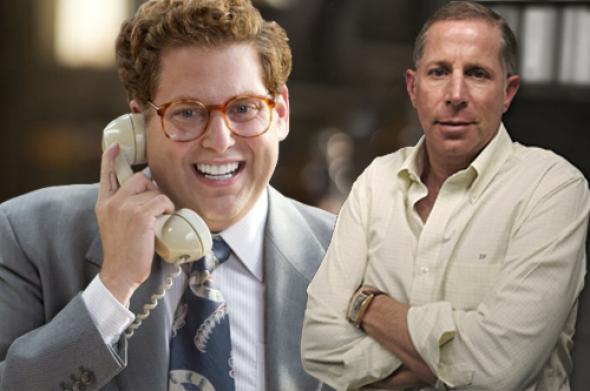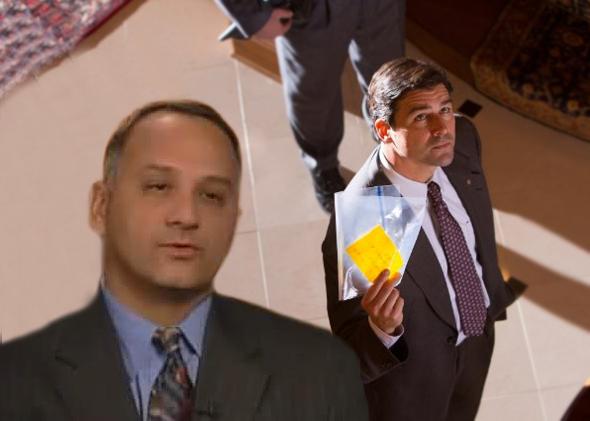For The Wolf of Wall Street, his latest collaboration with Leonardo DiCaprio, Martin Scorsese forewent his signature voiceover style in favor of more direct address: Throughout the movie, DiCaprio, playing the lupine financial huckster Jordan Belfort, looks into the camera and speaks right to the audience. Terence Winter, who wrote the screenplay, explains the use of the technique thusly: “You are being sold the Jordan Belfort story by Jordan Belfort, and he is a very unreliable narrator.”
It’s important to keep that in mind if you decide to dig into the fact and fiction of the film. The Wolf of Wall Street is quite faithful to the book by Belfort that it’s based on—though there are differences; the key ones are enumerated below. But how faithful is that book to reality?
It can be hard to tell, especially since some of its more outlandish tales turn out to be true. Nonetheless, below is an attempt to suss out the true-to-life from the merely true-to-Belfort in the film version of his story.
Jordan Belfort (Leonardo DiCaprio)

Leonardo DiCaprio, left, as Jordan Belfort, right
Courtesy of Paramount Pictures / Photo by Michael Loccisano/Getty Images
The broad outlines of Belfort’s story are faithfully rendered by the film: A talented but struggling salesman from Long Island, he got a job at venerable investment firm L.F. Rothschild, then was laid off after Black Monday. He went to work at Investors Center, a penny stock house, and a year later opened “a franchise of Stratton Securities, a minor league broker-dealer,” in “a friend’s car dealership in Queens.” He and his partner earned enough to buy out Stratton and form Stratton Oakmont, which he built into one of the largest over-the-counter brokerage firms in the country. (As in the movie, he hired some old friends.) He did an enormous amount of drugs—including, yes, Lemmon 714s—employed the services of countless prostitutes, and eventually went to prison for the pump-and-dump schemes that made him rich.
Much of DiCaprio’s dialogue comes straight from Belfort’s book, as do nearly all of the hard-to-believe misadventures: landing the helicopter on his lawn while stoned, crashing his car while severely high on Quaaludes, insisting that the captain of his massive yacht sail through choppy waters only to have the boat capsize and then get rescued by the Italian navy. Some of these stories are difficult to verify, but, for what it’s worth, the FBI agent who investigated Belfort told the New York Times, “I tracked this guy for ten years, and everything he wrote is true.” (Even the yacht story checks out.) As for the much discussed tossing of little people, shown at the beginning of the movie: Belfort’s second-in-command says “we never abused [or threw] the midgets in the office; we were friendly to them.” That same former exec says there were never any animals in the office, let alone a chimpanzee, and he says that no one called Belfort “the Wolf.” We know, at least, that the nickname was not coined by a Forbes writer. But, for the most part, it’s Belfort’s word against his.
As far as I can tell, Belfort is not a particular advocate of “sell me this pen,” a bit of sales interview role-playing that has been around for years. Another minor but notable difference between movie and reality: Belfort, unlike DiCaprio, is a short man, and multiple acquaintances have suggested that his lust for money, power, and attention are evidence of a Napoleon complex. As for the fidelity of DiCaprio’s portrayal otherwise, there are many videos of Belfort you can watch online, including one or two of Stratton Oakmont company parties.
Danny Porush/Donnie Azoff (Jonah Hill)

Photo courtesy Mary Cybulski/Paramount Pictures; Photo courtesy DannyPorush.com
The case of Donnie Azoff (Jonah Hill) is more complicated. For one thing, Azoff is a fictional name, and the character is sometimes described as a composite. His story closely matches that of Danny Porush—but Porush himself has disputed some of the details. Here are the basic facts: Porush lived in Belfort’s building, and he went to work as a trainee under Belfort before Stratton Oakmont. As History vs. Hollywood notes, he did not meet Belfort in a restaurant; they were introduced by Porush’s wife (and yes, she was his cousin; they have since divorced). He has admitted to eating a live goldfish that belonged to a Stratton employee, as depicted in the memoir and the movie, but denies the three-way with Belfort and a teenaged employee.
Porush was indeed a childhood friend of Steve Madden’s, and the initial public offering for that women’s shoe company was the biggest bit of business Stratton Oakmont ever did. Madden, like Porush and Belfort, served time in prison for participating in the Stratton scheme.
Nadine/Naomi (Margot Robbie)

Photo courtesy Mary Cybulski/Paramount Pictures; Home video still/CNN/YouTube
The names of Belfort’s wives were also changed for the film. Belfort divorced Denise Lombardo, called Teresa in the movie, after meeting Nadine Caridi at a Stratton Oakmont party. Caridi, called Naomi and played by Margot Robbie, was a model who had appeared in beer commercials; in the book, Befort calls her “the Miller Lite girl.” (You can see one of her ads below.) In both the book and the movie Belfort calls her the Duchess of Bay Ridge (or just the Duchess, for short), because she was born in England but grew up in Bay Ridge, Brooklyn. She really did have an English aunt (named Patricia, not Emma) who smuggled money into Switzerland on Belfort’s behalf, and who died while Belfort’s money was still in Swiss banks. (Belfort also had a drug-dealing friend with Swiss in-laws who did much of the smuggling—and that friend was later arrested after a botched money hand-off with Porush, just as we see in the movie.)
The scene in which Naomi spreads her legs open and tells Jordan he won’t be getting sex any time soon, only to learn that she is in full view of a security camera, is taken right from the book—as is the fight in which she throws water at her husband repeatedly. Belfort acknowledges hitting his wife in the memoir; he says he kicked her down the stairs. He also threatened to take their daughter away, putting her in the car with him and then crashing it into a pillar on their property. He was high.
Belfort and Caridi have since divorced.
Mark Hanna (Matthew McConaughey)

Graphic by Slate. Images courtesy courtesy of YouTube, Paramount Pictures.
The L.F. Rothschild trader who takes Jordan to lunch and tells him that cocaine and masturbation are the keys to success as a stockbroker is based on a real person whose name is not changed in the movie or the book. Mark Hanna has told his own version of the story on YouTube, and he does not seem to dispute the substance of Belfort’s account. (The lunch scene in the film combines two conversations from the memoir, using nearly identical dialogue.) Hanna himself was later convicted of stock fraud. He did not pound his chest and hum rhythmically, as McConaughey does so memorably in the movie; that flourish is based on an acting exercise that McConaughey likes to do, and was, according to the movie’s press notes, incorporated into the film after DiCaprio and Scorsese noticed the actor doing it on set.
Special Agent Gregory Coleman/Patrick Denham (Kyle Chandler)

Courtesy WolfofWallStreet.com/Photo courtesy Mary Cybulski/Paramount Pictures
Patrick Denham is another made-up name, but there really was an FBI agent who followed Belfort closely for years: Gregory Coleman. He told CNBC in 2007 that he was struck by the “blatantness” of Belfort’s financial crimes. As far as I can tell, they did not meet on Belfort’s yacht, as the movie suggests; in the book, Belfort first meets Coleman when the FBI arrives to arrest Belfort at his home. (The arrest did not take place while Belfort filmed an infomercial—that’s a bit of poetic license on Scorsese’s part.)
The Aftermath
After his arrest and indictment, Belfort cooperated with the FBI. In the film, Jordan, while wearing a wire, passes a note to Donnie telling him not to incriminate himself. Belfort did not pass such a note to Porush, but, in his second book, Catching the Wolf of Wall Street, he claims to have done just this for his friend Dave Beall. He ultimately served 22 months in prison and was ordered to pay over $100 million in restitution to his victims (which he has apparently failed to do). As the film depicts, he became a motivational speaker after leaving prison; at the seminar in the movie, DiCaprio as Jordan is introduced by the real Jordan Belfort (and, in real life, the actor has filmed a testimonial for Belfort). Belfort is not the only real-life participant to show up in the movie: A private investigator that Belfort employed, Richard “Bo” Dietl, is also in the film; he plays himself.
Previously
How Much of American Hustle Actually Happened?
The People Who Inspired Inside Llewyn Davis
How True Is Saving Mr. Banks?
How Accurate Is 12 Years a Slave?
How Accurate Is Captain Phillips?
How Accurate Is Dallas Buyers Club?